Vienna: Art, Wine and Politics
15 April, 2008, 05:14 am in "Austria"
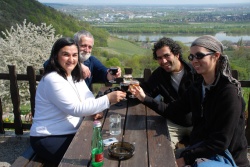 Our friends, Eric and Besra, met us at the train station and took us to their apartment near the center of the town. After a delicious lunch, Besra took us site seeing. We walked through a large street market to the road leading to the center, passing by Jugenstile buildings and the Secession, a building housing the Beethoven Frieze by Klimt.
Our friends, Eric and Besra, met us at the train station and took us to their apartment near the center of the town. After a delicious lunch, Besra took us site seeing. We walked through a large street market to the road leading to the center, passing by Jugenstile buildings and the Secession, a building housing the Beethoven Frieze by Klimt.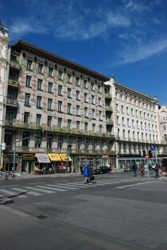
The center was packed with tourists and I saw to my utter disgust, it was infested with human statues.
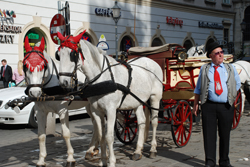
We ducked into St. Stephen's Cathedral, where the exterior was clad in the European building fashion of choice: scaffolding. Stepping into the doorway, we could feel the temperature drop.
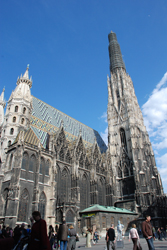
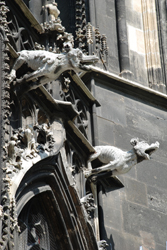
We looked around the cathedral, then walked through a gate into a quiet street which ran next to Mozart's house.
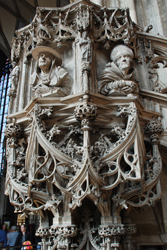
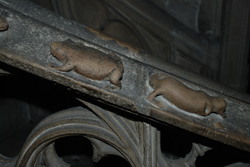
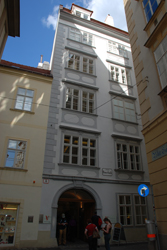
Back on the main square, we stopped to admire a door with ornate metal work.
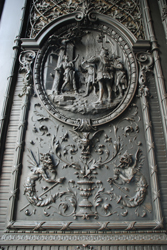
While drinking coffee, we heard sirens and the sound of a protest march. It turned out to be for squatter's rights. Within the next couple days, the news had stories of police and punks fighting. The squatters had occupied an abandoned building which the police raided, dragging the occupants out. We were also pleased to note that Bush was unpopular in Vienna as well as the rest of the world as expressed by a message someone wrote on their roof for when he was in town.
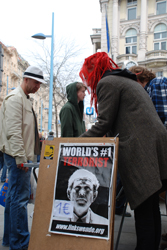
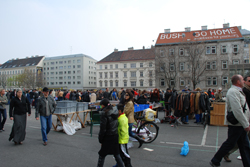
On our way back home we stopped by the Museum Quartier, a center with art museums, as well as other cultural spaces, as well as some other sights.
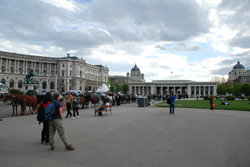
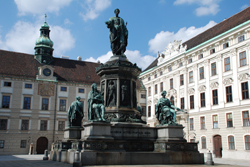
Art in Vienna
Eric is a glass artist. For 25 years he worked as an engraver for a major Austrian glass firm, until he developed a work related hand injury. Now he creates engraved pieces for his own enjoyment as well as other types of glass art. Rowshan became fascinated by the engraving techniques and wondered if it was possible to use the same techniques on ceramics. Eric was delighted by the experiment so on Saturday, he purchased a cheap ceramic mug from the street flea market and we all went to Eric's studio.
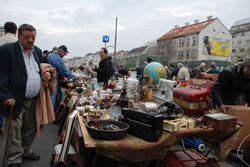
Eric showed us how to engrave glass. He also engraved a bird of Rowshan's design, into a ceramic mug. Both Eric and Rowshan liked the results. Rowshan attempted to engrave a piece of glass but decided it was too difficult.
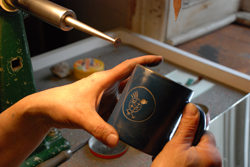
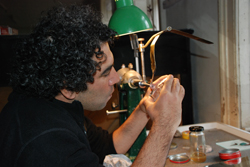
Although I'd been to Vienna before, I found I was a lot more interested in the art this time. We'd briefly touched on Jugenstile, the Viennese Secession, and Wiener Werkstadt in a design history class I'd taken last year, so I enjoyed being able to see examples of architecture and applied arts in these styles. Saturday was the free day at the Museum of Applied and Contemporary arts. Most of the exhibits were rooms full of furniture divided up by style/time: Art Nouveau, Art Deco, Baroque, Rococo, etc. There were also rooms of ceramics, glass and lace. Upstairs I was delighted to find a room with some Klimt paintings (roughs for a frieze) and a couple Glasgow School pieces including a frieze I recognized from my graphic design history textbook. There was a room devoted to carefully crafted Wiener Werkstadt samples. The early 1900s must have been a fun time to be in the Vienna art scene.
On Monday I went to the Leopold Museum. I went for the Klimt works but found the pieces by Egon Schiele and Albin Egger Liennz a lot more captivating. The first room of Schiele was mostly dark landscapes in muted or warm brown tones with an occasional splash of bright color. His people seemed ominous and distorted. I guess that seems to be a characteristic of expressionist painting.
Liennz's pieces were fascinating in how he changed during WWI from a realistic (romantic) painter of Tyrolean pastoral scenes to an expressionist painter of the tragedy of war. After working as a battleground painter, his figures became darker and distorted. His scenes became reductive and his strokes heavier.
The Leopold Museum is in the Museum Quartier, a place I decided I liked a lot. The buildings create a courtyard where people lounge on benches. All around are museums, art studios, and creative spaces. One space I went into had an interesting exhibit where touching plants caused designs to grow on a screen.
While I was at the museum, Rowshan went to see the UN building and a business complex near the Vienna Needle and the danube park. It was a peaceful place with lots of flowers, art work and birds.
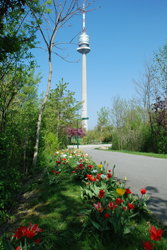
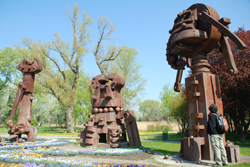
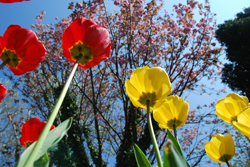
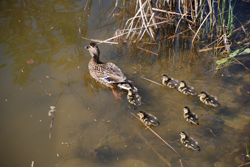
Kallenberg
An important aspect of city life is knowing where to go when one needs to escape the city. Besra and Eric took us to the top of a hill North of the city but easily accessible by public transportation. On the hill, was a church from where the United Christian Kingdoms set out to defeat the Turks and prevent them from taking Vienna. It is also said that when the Turks retreated, they left bags of coffee which introduced the drink to Europe. From the top of the hill, we had a beautiful view of the hazy city below. We walked down the hill. Below us were vineyards. The rows of trimmed, brown vines were separated by strips of dandelions and forget-me-nots. We stopped at a small restaurant selling home-made wine and sat, contentedly sipping wine at an outdoor table, and enjoying the view of the Danube.
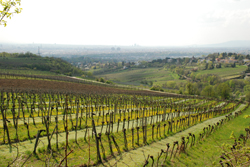
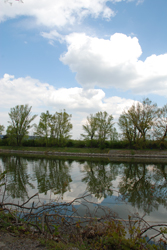
[ View 1 Comments
|
]
Comments
esther ong -
posted on 6/15/2008
Vienna, can be quite crowded...been there over 15 yrs ago. Nice to see it again.
This is an amazing trip for you!! Wow, you have kept on for almost a year!
This is an amazing trip for you!! Wow, you have kept on for almost a year!
Powered by My Blog 1.69. Copyright 2003-2006 FuzzyMonkey.net.
Created by the scripting wizards at FuzzyMonkey.net..
(Code modified by Rowshan Dowlatabadi)
Created by the scripting wizards at FuzzyMonkey.net..
(Code modified by Rowshan Dowlatabadi)

